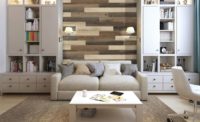Design Advice for RSAs from Candice Olson

Canadian designer Candice Olson is the host of Toronto-based home-makeover shows Divine Design and Candice Tells All, which aired in both Canada and the U.S. With a finger on the pulse of all things design, Olson is pushing trends, inspiring spaces and influencing the design decision of thousands across media platforms. Olson recently sat down with Shaw Flooring Network members to discuss the processes behind the interiors she designs and her outlook for the industry.
Q: When working with a new client, how do you learn about their lifestyle and ultimate dreams for their space?
Olson: Meeting new clients is always interesting because I don’t think they realize how much work is involved before we actually start demoing or doing any sort of construction. It can be pretty exhausting, but in the end, it's always worth it. Whether it's a reno or a ground-up home design, there's always a lot of detective work, full-on interrogation, maybe a little bit of therapy. But that's all part of me getting to know new clients.
I always say that it’s as if I'm going to come and live with you—which can be a terrifying thought—but I almost have to become a member of their family, but just in my mind. There's a whole rationale to it. If I'm really going to understand their lifestyle, I need to understand their lives. I want to know all about everybody in the home—from mom and dad, if there's kids, if there's pets, if there's in-laws—I need to know all of the typical schedules and the rituals from morning to night, weekdays and weekends as the dynamics of the home change during those times. I need to know bathing, cooking, eating, working, studying, exercise and fitness, socializing, entertaining, sports hobbies; you know, who's doing what at any given time while in the home. How are they actually living in their home?
That’s the first almost meeting. It’s very Dr. Phil. I also asked if they see that changing in the next few years because we are designing for the future as well. So is their family is growing and evolving and changing? I need to gather all of this practical info to learn how the home needs to function before I design anything. The saying in design is “form really does follow function.” The design has to follow the function. Designing a beautiful space is easy. Designing one that functions beautifully and can stand the test of time, that's the challenge.
Q: To ensure that they get their dream space, what guidelines or best practices do you follow with every customer?
Olson: That is the next stage. We're a design-build company and there are so many moving parts and so much coordination that is required in design build that I really try to have every last detail designed, priced, signed off and ideally ordered prior to any construction. I love to see a design concept come to life, but doing an on-time and on-budget makes me even happier and makes my clients even happier. The only thing more frustrating than waiting for an order to arrive, is holding up a project waiting for a decision on what to order. It drives everybody crazy and if the project is going to go off the rails, that's where it does.
Q: How do you shift consumers to the right products for their spaces, especially if they have expressed interest in something that might not hold up to their day-to-day lifestyle?
Olson: If we’re talking flooring, which we are, I always start with the practical aspects, starting with the site conditions: what's the climate, heat, humidity factors? Is it a below grade? What’s the condition of concrete? Is it a newer home or are we dealing with an older home with uneven floors? All of these conditions affect what products I'll propose to the client. It helps determine the budget as we need to know not just the raw product cost, but what’s the prep work involved? What are the installation costs?
Another factor is what is the intent of the space? Is it a high-traffic, low-traffic situation? What’s the wear and tear, what kind of comfort and durability is needed? Budget is always a factor. With so many options of there, I can always get the look for less, but it still needs to stand the test of time. I tell clients this all the time: selections needs to be thought of as investments in the home. Clients love to save money but getting the look with a poor-quality product is not investing in their home, it’s just spending on their home. They're just throwing money out the window because it won't last. And replacing a floor is the most disruptive and expensive thing to do down the road, so we need to choose wisely.
The last, the most important factor, is the design content and the style that we're after. Are we looking for a reclaimed barn board look? Or a more rustic, urban farmhouse? Or an industrial look? Or are we looking for a light, quiet grained floor, or contemporary Scandinavian-inspired space, or a floral mosaic? The decision to go with a certain product is always made in context as part of the whole concept.
Q: What is next for design?
Olson: This has been interesting for everybody in this business. So much of our time was spent traveling around trying to connect with clients. This format, as much as it's been a horrible situation that has led to this, we're really trying to take a look at how we can take the best of this moving forward.
If I would have had this sort of technology back with my very wealthy clients, it would have been a whole lot easier to communicate. It really does make things more efficient. It's not so personal—I can't reach out and give you a smooch, but it really has sped up the process. What we're finding now is decisions are getting made, but supply is not keeping up. We're trying to figure out how we structure our business going forward.
Looking for a reprint of this article?
From high-res PDFs to custom plaques, order your copy today!






